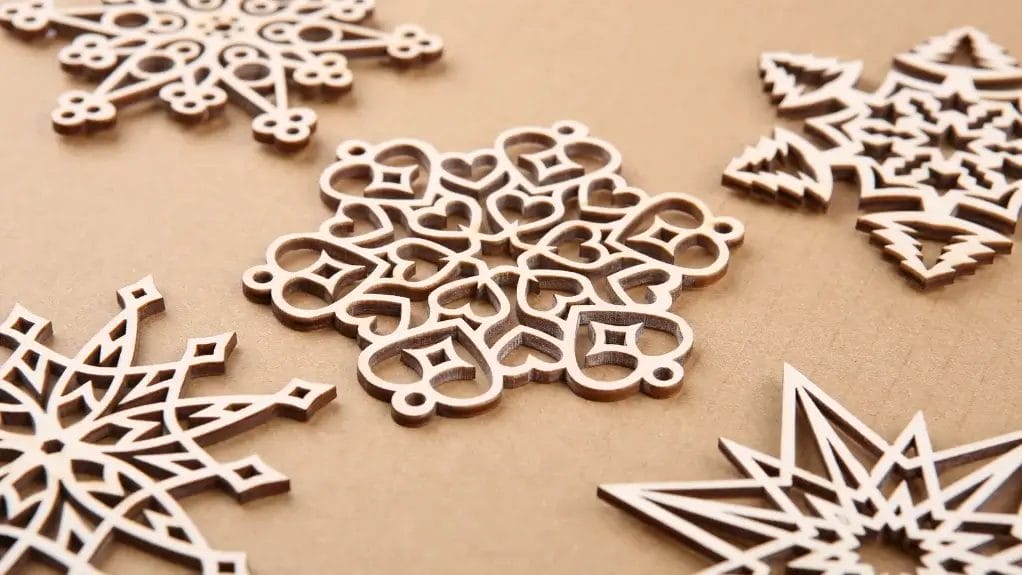Are you curious about how to make a cutout in wood? When we’re tasked with creating precise wood cutouts, we rely on more than basic tools and intuition. Our manufacturing approach combines traditional craftsmanship with modern technology.
Whether we’re running a production line or handling custom orders, understanding the entire workflow — from material selection to final quality control — enables us to transform the wood cutout process into a streamlined operation for our customers.
Key Takeaways
- We select high-quality plywood or OSB free of knots and seal the surface with primer to improve paint adhesion.
- We use professional tools like CNC routers, laser cutters, band saws, and jigsaws, choosing the right blade and settings for each task.
- We create precise digital designs in CAD software and export compatible files to ensure accurate and consistent machine cutting.
- We maintain strict quality control at every stage, sanding edges and measuring dimensions to guarantee product quality.
Essential Tools and Equipment for Industrial Wood Cutouts

For our professional wood cutouts, we rely on powerful equipment, including CNC routers and laser cutters. They provide the precision and automation needed for complex designs.
We use band saws to produce smooth curves and to cut through thicker stock. Jig saws give us the flexibility to handle intricate patterns and interior cutouts.
CNC Routers
Precision and efficiency are vital for our industrial wood cutouts. So, CNC routers are indispensable.
We use a router to produce complex cuts with unmatched accuracy. This is thanks to its computer-controlled system and multi-axis capabilities.
To get the most out of our CNC router, we start by designing in CAD software and generating the necessary files for the machine.
Our routers handle a range of materials from plywood to MDF. Selecting the correct cutter bit and feed/spindle settings is essential for achieving optimal results.
We also maintain strict routines, including regular bit sharpening or replacement, and machine calibration, which ensure our cuts stay precise and the router performs reliably for years.
Laser Cutters
A laser cutter provides unmatched precision for industrial wood cutouts. This is thanks to its high-powered beam technology. We can achieve intricate cuts in both plywood and hardwood at impressive cutting speeds of several meters per minute.
Because the machine can both cut and engrave, we incorporate detailed designs and patterns directly into our projects. Doing so saves steps and expands our product offerings.
Before running the cutter, we always verify that all safety features are active. Those include the exhaust system and interlocks — to protect our team from harmful fumes.
In our experience, laser cutters significantly reduce production time and material waste compared with traditional methods. They’re a highly efficient choice for professional woodworking.
Band Saws
Band saws remain a cornerstone of our industrial wood cutouts. Their continuous blade design is ideal for creating holes and cutouts with minimal waste and reduced edge tearing.
We use a range of blade types—narrow blades for intricate details and wider blades for more aggressive cuts—so we can match the blade to each task.
For complex projects, we tilt the adjustable table to perform bevel cuts, giving us precise control over angles. The saws’ lower noise and vibration levels help our team stay comfortable during long cutting sessions.
As a versatile machine, the band saw serves both roughing and finishing roles in our workflow.
Jigsaws
Powerful and precise, jigsaws excel at creating intricate wood cutouts and curved designs that other power tools can’t match. When we make a cutout, we select the right blade based on material thickness and the precision required.
| Feature | Benefit |
|---|---|
| TPI Options | Varied cutting precision |
| Orbital Settings | Enhanced cut quality |
| Speed Control | Better accuracy |
To get the best results, we adjust the jigsaw’s speed and orbital settings to suit each project. The blade’s up-and-down motion allows us to navigate complex curves with ease. Meanwhile, using orbital settings and the appropriate blade type helps achieve smoother finishes.
How to Make a Cutout in Wood: Step-by-Step Workflow

We begin our workflow by carefully selecting and preparing raw materials to ensure stability and consistent results.
Next, we draw and create detailed design blueprints and digital models. Then, generate the appropriate machine files and precisely calibrate our CNC routers or other equipment.
With our systems ready, we execute the cutting process and maintain strict quality-control checks at each production stage.
Raw Material Selection and Preparation
For high-quality wood cutouts, we begin by choosing the right material. We select plywood or OSB that’s free of knots and defects to ensure the cutouts’ structural integrity. Before we cut, we seal the wood surface with a primer to improve paint adhesion.
| Material | Purpose | Tools Needed |
|---|---|---|
| Wood | Base material | Saw |
| Sealer | Surface prep | Brush |
| Sandpaper | Edge finishing | Sanding block |
| Paint | Final finish | Brushes |
Design and Digital Modeling
Before we begin the physical production, mastering the digital design tool selection is essential for achieving precise results.
We create our digital model using software such as Adobe Illustrator or CorelDRAW. We outline the cutout shape and add any intricate details required in the final piece. We usually draw a square outline on the plywood as our basic cutout shape.
We always account for material thickness and the chosen cutting method while designing. These factors determine the level of detail we can reliably achieve.
Finally, we export the design as a vector file (SVG or DXF) to ensure compatibility with our systems. This preserves precision and quality for complex cuts.
Machine Setup and Calibration
Once the design phase is complete, proper machine setup and calibration become essential.
We start by fitting a fine metal cutting blade to the circular saw and adjusting its depth. So it can barely protrude beyond the wood’s thickness.
We always secure our template or guide firmly to the work surface with reliable clamps, and position the saw’s shoe against the cutting guide to ensure precise alignment.
Before making any cuts, we double-check that all attachments are tight and correctly calibrated. This preparation keeps us in control during plunge cuts, ensuring smooth and accurate results.
Cutting Execution and Quality Control
We start cutting with a plunge cut using a circular saw for straight sections. Then, we use a handsaw for corners and tight spots. For interior cutouts, we may also use a jigsaw or plunge router, depending on the geometry. To begin interior cutouts, we first drill a starter hole to insert the jigsaw blade.
| Process Step | Tool Required | Quality Check |
|---|---|---|
| Clamping | Bench Clamps | Stability |
| Marking | Pencil / Ruler | Accuracy |
| Cutting | Circular Saw | Straightness |
| Corner Work | Hand Saw | Precision |
| Finishing | Sandpaper | Smoothness |
After cutting, we inspect all edges and smooth any rough spots with progressively finer sandpaper to achieve a professional finish.
Finally, we measure the finished dimensions against the specifications and record the results to verify that our quality standards are met.
Quality Assurance: Ensuring Precision and Consistency

Achieving precise wood cutouts requires careful attention to both our tools and our technique. We begin by setting the proper cutting depth on the circular saw and marking clear reference lines on each workpiece.
We always securely clamp the material to prevent movement during the cutting process. We check blade sharpness and saw alignment before starting to ensure consistent performance throughout the run.
We avoid rushing: deliberate, controlled movements while guiding the saw along marked lines reduce errors and produce repeatable, professional results.
Customization at Scale: Meeting Diverse Client Specifications

When scaling up wood cutout production for multiple clients, successful customization depends on efficient systems that maintain consistent quality across diverse specifications. We rely on digital design tools to customize each project precisely while managing multiple orders simultaneously.
| Client Needs | Production Solutions |
|---|---|
| Design Intent | Digital Consultation |
| Dimensions | Precision Templates |
| Material Choice | Stock Management |
| Timeline | Workflow Scheduling |
| Special Features | Custom Tool Setup |
We thoroughly document each client’s specifications during consultation to ensure that all requirements are captured before production begins. Our digital tools translate those specifications into precise cutting templates, which helps us maintain consistency across orders.
We also keep our portfolio current to demonstrate our capacity to handle a wide range of customization requests.
Sustainability and Waste Management in the Cutout Process
Sustainable wood cutting practices begin with informed material choices and effective waste reduction strategies.
We minimize material waste by selecting alternatives like Coroplast where appropriate and by repurposing reclaimed wood for suitable projects.
We concentrate on clean cuts and careful nesting/layout planning to reduce the total number of cuts. This ensures more efficient use of sheet goods and lower scrap rates.
To boost sustainability, we keep our tools well-maintained and recycle worn-out consumables, such as saw blades and router bits, whenever possible. Regular maintenance not only supports greener practices but also extends the life of our equipment and improves cutting efficiency.
When designing cutouts, we strategically plan cut layouts to maximize material usage and reduce energy consumption across production runs.
Final Words
Mastering wood cutouts is essential for our industrial production efficiency. By following standardized processes, maintaining strict quality control, and implementing sustainable practices, we ensure consistent results while minimizing waste.
Whether handling small batches or large-scale operations, we regularly calibrate equipment and keep our team trained on the latest cutting techniques. Our attention to these details guarantees professional-grade wood cutouts every time.
We provide a broad selection of wood cutouts, available for bulk orders and custom designs. Reach out to us for more details.
FAQs
How to Make a Slot in a Piece of Wood?
You’ll need to mark the outline of your slot, select a suitable saw, such as a circular saw, adjust the blade depth, make controlled passes while cutting, and clean the edges with sandpaper for a smooth finish.
How to Make Your Own Cutting Board Out of Wood?
You’ll need hardwood, such as maple or walnut. Cut it to size, sand thoroughly from coarse to fine grit, round the edges, and finish with food-safe mineral oil. Regular maintenance keeps it in top condition.
What Is the Best Tool for Wood Cutouts?
You’ll get the best results with a jigsaw for curved cutouts and detailed work. For straight cuts, use a bandsaw. If you’re working on intricate designs in thin wood, choose a scroll saw.
How to Make a Notch in a Piece of Wood?
First, mark your dimensions carefully with a pencil. Then cut along the lines using a circular saw. Clean the corners with a handsaw, chisel out the remaining wood, and sand the edges for a smooth finish.






































